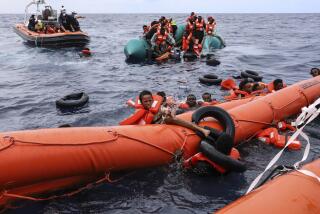Stockholm Pact Provides ‘a Mechanism to Spot Warning Data in Time of Crisis’
- Share via
STOCKHOLM — The new Stockholm package of confidence-building measures that will come into operation across continental Europe on Jan. 1 will not reduce the size of armies or number of weapons, but it will produce a new collective system of openness about military activity unprecedented in European history.
Never before have all the nations of Europe gotten together to work out rules and guidelines for exchanging hitherto classified information about military movements and plans for maneuvers, along with arrangements to exchange military observers wherever and whenever major military maneuvers are taking place.
For the first time in history, it will be possible for a colonel in the Portuguese army, for example, to travel from the Atlantic to the Ural Mountains to watch the Soviets exercise their army.
Military staff officers from the North Atlantic Treaty Organization countries who have been negotiating the confidence-building package acknowledge that the new openness is unlikely to add very much intelligence information to what is already known about the size, location, equipment and organization of military forces of either East or West. That is not the purpose, and if either side thought that it might be exposing a lot of fresh secrets, then there probably never would have been a Stockholm agreement.
Will Know What to Expect
“What we have tried to set up is a mechanism to spot warning data in a time of crisis,” one of these staff officers said. “We will now be able to watch the pattern of military activity on either side, knowing in advance what to expect. If there is any unusual or unexplained variance from what we have been told to expect, we will of course be able to spot it promptly and make our assessment of its significance. That will be a totally new situation in our monitoring of Warsaw Pact activities and will go a long way to ensure against sudden buildup or surprise attack in Europe.”
Here is how the new confidence-building system will operate:
On Nov. 15, all of the 35 nations that have signed the Helsinki Accords and have military forces in Europe will circulate to each other a list of all land exercises of up to 40,000 men that they intend to hold during the next two years, along with any exercise they might be planning for up to 75,000 men during 1988. Dates for the exercises on this notification list will be approximate.
Forty-two days before an exercise is due to take place, the nation conducting the exercise will be required to notify all other European states of the exact date, the composition of forces by overall numbers as well as units (regiments, brigades, tanks, artillery), location and the purpose of the exercise.
Any power will then be free to advise that it will send military observers to watch the exercise--with their own binoculars--through aerial and/or ground inspections.
Western delegates expect that initially this notification system will produce an average of perhaps one exercise per week under observation in either Eastern Europe or Western Europe.
Notice of Unusual Movements
Some maneuvers will be “notified” but will be too small to come under the “observable” category. There will also be notifications of unusual troop movements--such as U.S. reinforcement exercises in and out of Europe.
“Each year we will exchange new updates on the planned maneuver pattern for the next two years ahead,” the Western staff officer explains. “We will then, all of us individually and collectively, be able to build up a pretty clear picture of what to expect, month by month, and in particular spot anything unusual which we have not been told about in advance. Of course, without such advance information, we would be left in the dark to figure out what was unusual and what was not.”
For military men accustomed to staging and commanding exercises of their own, it is not military secrets that are important in watching maneuvers, but military performance. Regular observation of Warsaw Pact forces all the way back into the Soviet Union east to the Urals on an estimated 10 to 15 occasions a year will certainly add to Western assessments of just how good the Soviets are, apart from how powerful they seem.
If there is sudden intelligence information or suspicion of some major unusual military activity without notification, a challenging power will have the right of an immediate automatic aerial inspection of the area of suspected activity within 12 hours. A secret Soviet buildup of troops on the Polish borders, for example, might be such an event.
More to Read
Sign up for Essential California
The most important California stories and recommendations in your inbox every morning.
You may occasionally receive promotional content from the Los Angeles Times.













